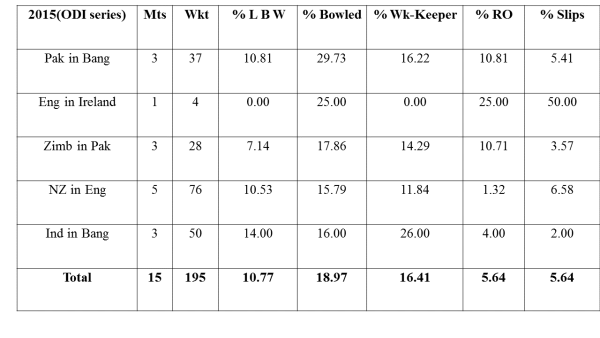At the end of India Bangladesh ODI series (June 2015)15 ODIs games were played after WC 2015. The average score for first batting (including abandoned games) is = 291.80 in which 8 times teams went past 300 score(6 wins).
And this is mainly due to openers who are having a time of their lives with the bat!. The opening stands is @ 57.67 featuring five hundred partnerships.
They(bat No 1 & 2)compiled more than 2000 runs in these 15 games, which constitutes 31.30% of total runs scored by teams. Here is there stat table.
| Bat | Inn | Runs | 100s | Avg | Scoring rate(100balls) | St.Rate | Boundary rate |
| I | 29 | 1322 | 4 | 48.96 | 46.8 | 112.93 | 10.98 |
| II | 29 | 1115 | 1 | 42.88 | 48.8 | 95.78 | 14.51 |
Adding to openers, No.3 is also having a gala time with the bat, and if one has to sum up top 3 runs, than their contribution to team score is 45.35% runs.
| Bat | Inn | Runs | 100s | Avg | Scoring rate(100balls) | St.Rate | Boundary rate |
| III | 29 | 1088 | 4 | 41.85 | 51.10 | 105.33 | 11.43 |
Now can bowlers tilt the scale ?. Sure they can balance play!.
Here is how,
- Close-in fielding is the X-factor – fielding can even the balance in one day cricket, especially slip fielding.
- if wickets fall in cluster, few close-in catching can help bowlers, in every phase of an inning.(Bangladesh did well to choke Indian batsmen)
- Keep the ball shiny -With two new balls used from each end, the shine on the ball will remain intact for some time which should allow bowlers to swing/seam and bounce consistently.
- Bowling changes: Constant bowling changes and shorter spells for specialist bowlers have enabled bowling side to choke runs in every phase….however this has not been maintained consistently by bowling side.
Here is a stats piece on slip fielding since WC2015. The table below is list of method of dismissals series wise
For me this fielding data is an interesting stats.
- The percentage of slip catches is equal to run-out dismissals,
- and if one can add genuine edges to keeper(all phases) than all three elements strengthens fielding data.
Although I was not able to cover ball2ball data of all 15 games, but updated type of slip catches in scorecard. This enables us to find out its effectiveness in an inning.
– Overall there were 11 slip catches against all type of bowling and all type of shots played. In this
- 3 came inside 10 overs and after 40th over!.
- 3 were of middle/lower order batsmen.
- 4 top order (1 to 4)batsmen were dismissed inside 15 overs.
- 5 were dismissed inside 10 runs(out of which 3 were top order batsmen)
- 3 were picked by spinners(Yasir and Rashid) and they all were specialist batsmen.
– Now if we add keeper’s dismissals to slip dismissals than fielding stats can enhance bowlers.
Nevertheless was surprised to see only 3 (out of 32) catches were taken inside first 10 overs. Yet it was heartening to see that 10 came after 40th over, suggesting that irrespective of type of shot played, there is enough opportunity for wickets to be picked behind the wicket (including slip to gully region)in all phase.
Before concluding this post, would like to add some thoughts on captaincy when bowling.
I am very impressed the way Brendon McCullum is leading Blackcaps. His motto while fielding is to pick wickets irrespective of situation or position his team is in. However this particular incident in first ODI(9th June,2015) against England could have been avoided, and it is not my hindsight theory as I marked this over while covering this game ball2ball… and thought “have a second slip mate”!!.
“When Josh Butler came into bat, McCullum kept a slip for Trent Boult(left armer) (normal position) and Josh edged past that slip, where normal 2nd slip stands….the next over he switched his 1st slipper wider and placed him where the ball had gone(viz 2nd slip), but this time the ball went finer, where 1st slip was positioned!!.
I must admit that the argument would be “this usually happens to every fielding team” and i don’t disagree…
Hence my theory is – when you believe that wickets is key to stop runs(restrict them for low score), than why are you constraining yourself with number of fielders. Have maximum(air tight)fielders in place that will fetch you wickets, or, probability of wicket is higher….than worrying of less fielders in boundary, or where runs are scored constantly should not matter to you. The focus should be to strengthen that part of field where chances are high of picking wickets in that period.
And when you have skilled swing bowlers, slips are best option to maximize that.
Butler(like many contemporary batsmen) plays unorthodox shots(mostly combination of vertical/horizontal shots), and when he edges or errs, one cannot predict where the ball might go….it can be 1st or 2nd slip, or even over them.
Infact if one has to compare error shots of orthodox and unorthodox batsmen, its difficult to predict the later. Nevertheless its worth taking a chance for a short period of time to to get their wickets, otherwise in short time these batsmen can take the game away from you.
The NZ ENG series had many drop catches(at least two per game), and same can be said in India Bangladesh series. Teams should look into improving their fielding skills, and at least in first 10-over employ attacking field irrespective of target they are defending.
Here are links to fielding post.
http://allthatcricket.com/?p=7704
http://allthatcricket.com/?p=7444
http://allthatcricket.com/?p=6967
http://allthatcricket.com/?p=3627
http://allthatcricket.com/?p=3630


